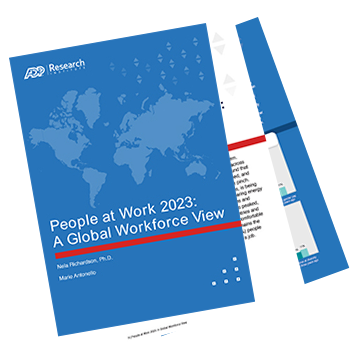In 1948, the United Nations’ Universal Declaration of Human Rights (UDHR) stated that ‘Everyone, without any discrimination, has the right to equal pay for equal work’.1
A lot has happened since then, including gender wage discrimination becoming illegal in many jurisdictions, but much remains to be done.
In fact, many respected organisations believe that at current rates, the gender pay gap could take decades if not centuries to close.
The findings from ADP Research Institute’s latest annual study of employee sentiment — People at Work 2023: A Global Workforce View — support these concerns. Our research shows there are still significant differences between the earnings of men and women across the European nations in our study.2
And although this article focuses on gender pay disparities in Europe, this is an issue that crosses cultures and country borders. So even where companies have made progress with both gender equality and women’s participation in the workplace, societal, cultural and sometimes religious inequalities can still hinder progress.
How progress varies across Europe
While on average 34% of male and 25% of female workers believe their company is better at gender pay equality compared to three years ago, the proportion who agree in each nation varies widely:
- Italy 24%
- UK 27%
- Netherlands 28%
- Poland 28%
- Germany 29%
- France 35%
- Spain 36%
- Switzerland 45%
45% of Swiss workers say gender pay equality has improved in their company in the last three years but only 24% of Italian workers would agree
The importance of pay
Unsurprisingly, most of Europe’s workers rate ‘salary’ as the most important reason for going to work. Over six in 10 (62%) of employees say so; a figure very close to the global response (61%).
But the significance of salary varies between the sexes, with more women (67%) saying it’s important than men (59%). Ironically, despite this relative ranking, fewer women (36%) than men (41%) are satisfied with theirs.
What’s more, although inflation varies from country to country and is falling across Europe, half of the region’s workers (50%) are expecting a pay rise in the next 12 months to help ease the pressure on their household budgets.
Factors influencing the gender pay gap:
- The glass ceiling
Obstacles that prevent women moving up the career ladder - Sticky floors
Disadvantages that hold women back in lower-paid roles - Motherhood penalty
Loss of lifetime earnings by women raising children
How Europe’s gender pay gap compares to the rest of the world
Europe’s generally viewed as one of the most progressive, employee-friendly regions of developed nations. Yet this year’s People at Work study shows that its major economies still have work to do to deliver gender pay equality.
Specifically, the pay rises that women in Europe have recently received simply haven’t kept pace with those of men. Little wonder, then, that women also expect less this year.
For example, last year men’s pay rises averaged 6.7% compared with 6% for women globally. Men expect to see their pay increase by an average of 8.5% in the year ahead, while women foresee rises of around 8%.
These global disparities are reflected in Europe. Last year, men’s pay rises averaged 5.7% compared with 4.9% for women. And, once again, women expect to receive a wage uplift of around 6%, while men expect to pocket an average rise of 6.6%.
More women than men in Europe believe they’re underpaid:
- 48% of men feel underpaid for their job
- 56% of women feel underpaid for their job
A new pay transparency directive from the Council of the European Union (EU)
EU companies face new rules on pay transparency. They’re required to share information about how much they pay women and men for work of equal value and act if their gender pay gap exceeds 5%.
Provisions include:
- Companies with more than 250 employees must report annually on their gender pay gap
- Smaller organisations (initially those with over 150 employees) must report every three years
- Compensation for victims of pay discrimination
- Penalties, including fines, for employers who breach the rules
- Compulsory information for job seekers about starting salaries and pay ranges of positions
- Banning questions regarding a candidate’s pay history
- Intersectional discrimination*
- Burden of proof change — employers must prove they’ve not violated EU rules
The EU Pay Transparency Directive came into force on 6 June 2023. EU member states have until 7 June 2026 to transpose its provisions into their national laws.
*Intersectionality
The cumulative way in which multiple forms of discrimination (such as race, disability and, in the case of this article, pay and gender), can overlap or intersect — especially in the experiences of marginalised individuals or groups.
Beyond pay – how the genders compare in their careers
- 'I'm satisfied with my career progression'
Men 39% — Women 35% - ‘My employer and I talk about career progression’
Men 51% — Women 45% - ‘I'm noticed and recognised for my contributions'
Men 57% — Women 53% - 'My employer provides financial wellbeing advice'
Men 43% — Women 33% - Average number of unpaid overtime hours a week
Men 7.38 — Women 6.11
Europe’s gender pay gap — it’s not just business, it’s personal
When it comes to how workers regard pay equity progress, the headline findings from our study were not promising. Almost half of Europe’s employees (43% of men and 50% of women) think their employer hasn’t made any progress on gender pay compared to three years ago.
But when we drill down into the detail, we find the picture is more nuanced. For example, of the workers dissatisfied with their current employment, 11% of women cite the gender pay gap as a factor but only 5% of men agree.
What’s more, this level of dissatisfaction with the gender pay gap falls as workers get older, from 10% of 18–24-year-olds to just 7% of 55+-year-olds.
Indeed, the findings from our research into the impact of the gender pay gap don’t only differ between men and women. They also vary by age range, parental status and the ages of dependent children, as well as by region and the size of the employer.
Interestingly, globally 53% of staff in the biggest corporations (with 1000+ employees) say they’ve noticed an improvement in gender pay equality at their companies. But in Europe, only 29% of workers in the largest enterprises say the same. In mid-sized firms, it’s a similar story — European workers are simply not seeing the same progression in the closing of the gender pay gap as their global counterparts.
“My company is better at gender pay equality compared to three years ago” |
||
|
|
Companies employing |
Companies employing |
|
Globally |
58% |
65% |
|
Europe |
33% |
31% |
Gender workplace equality - what difference does family status make?
“My company is better at gender pay equality compared to three years ago”:
- 28% of parents agree/32% of non-parents agree
- 23% of mothers agree/33% of fathers agree
- 29% of parents with children aged 0 — 10 years old agree
- 20% of parents with children over 18 years old agree
Why closing the gender pay gap matters
Numerous studies have shown that employees who are satisfied with their organisation’s commitment to diversity, equity and inclusion (DEI) are twice as engaged as dissatisfied employees. Closing the gender pay gap can bring similar benefits for the leaders of Europe’s businesses:
Helping companies to recruit and retain the best talent, by:
- raising the morale and motivation of the whole team
- enabling an organisation to promote itself as a fair and transparent one
- relieving the HR team of the unenviable task of having to recruit for, and explain away, an inequitable salary strategy
Regulatory compliance: limiting the risk of punitive fines and reputational damage that could result from non-compliance (see the new pay transparency directive from the Council of the European Union mentioned above)
“Transparency is an important, and often forgotten element to closing pay gaps. Information really is power and giving employees more information about the pay of their colleagues and for similar roles in their industries can help women gain negotiating power and narrow pay gaps over time.”
- Nela Richardson, ADP Chief Economist and Head of ADP Research Institute
Employers ignore the gender pay gap at their peril
In earlier research3 by ADP Research Institute we discovered that 69% of Europe’s workers — 65% of men and 73% of women — said they'd quit their job if they found out their employer had an unfair gender pay gap.
To help close the gender pay gap, employers should:
Support parents with …
- reliable, affordable child and family care and
- flexible work options (such as part-time and job share opportunities)
Hire more women at senior leadership positions …
- female representation at the top is key
- it helps address pay and role disparities
Promote transparency …
- Provide employees with data about company and industry-wide salary rates
Examine and close pay gaps …
- work to avoid them in future
- make equity a core organisational value
- have clear policies and practices in place
Delivering the right data to drive pay transparency in Europe
Given the economic climate, employers can’t afford to overlook the importance of pay — and fair pay — in employees’ lives.
Business and HR, payroll and finance leaders can drive down wage disparities and keep the gender pay gap closed for good by introducing an integrated payroll and HR system that can provide the accurate, real-time data they need to achieve these goals.
What’s more, an effective workforce compensation strategy, which helps a business to achieve the right salary levels and is equitable to both genders, can enable the organisation to recruit, reward and retain talent in a tight labour market.
“In a recent ADP study,4 27% of payroll professionals in European companies said that ‘DEI (including pay transparency/pay equity)’ is a key business driver for transforming their payroll operations over the next two to three years. It’s encouraging to see more and more European firms prioritise this, especially when 35% of these same employers acknowledge they lack the required analytical resources on their payroll team. As we’ve seen from previous ADP studies, it’s not just about achieving baseline compliance with new laws like the EU Pay Transparency Directive. Firms need to actively prove to workers that they’re rooting out unfair gender pay practices if they hope to hold onto increasingly switched-on staff.”
- Corinne Carles, Senior Director Total Rewards at ADP
To discover more insights into the gender pay gap as well as a wide range of exclusive global, regional and local workforce findings, download your free copy of People at Work 2023: A Global Workforce View.

What workers want and how you can deliver it
Undertaken between 28 October and 18 November 2022, People at Work 2023: A Global Workforce View is a study by the ADP Research Institute® that brings you vital intelligence into the attitudes, aspirations, wants and needs of 32,612 workers in 17 countries, including over 8,613 working exclusively in the gig economy.
Sources:
1- United Nations
2- ADP Research Institute, People at Work 2023: A Global Workforce View – European countries surveyed were France, Germany, Italy, the Netherlands, Poland, Spain, Switzerland and the UK
3- ADP Research Institute, People at Work 2022: A Global Workforce View – European countries surveyed were France, Germany, Italy, the Netherlands, Poland, Spain, Switzerland and the UK
4- ADP, The potential of payroll in 2024: Global payroll survey

